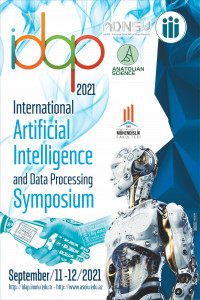EGA-Net: Analysis of Facial Expression, Age and Gender of Manufacturing Employees with Deep Learning Methods in the Industry 4.0 and Digital Transformation Era
Abstract
Nowadays, analysis of people's facial expressions, age, and gender by computer has become a considerable research topic together with technological advances in the area of human-machine interaction research. To provide this analysis, convolutional neural network algorithms that do not need manual feature extraction are widely used. In this study, two different data sets, CK+ and UTKFace, have been used to analyze the facial expression, age, and gender of manufacturing employees. These data sets have been used in the training of four different novel convolutional neural networks architecture designs. The convolutional neural network architecture design that achieves the best classification performance has been called as EGA-Net. After that, the weight files of the EGA-Net have been used together with the OpenCV library. Thus, facial expression, age, and gender have been analyzed in real-time.
Keywords
Convolutional neural networks EGA-Net facial expression analysis age analysis gender analysis
Project Number
2021-TYL-FEBE-0009
References
- Levi G, Hassncer T. (2015) Age and gender classification using convolutional neural networks. IEEE Computer Society Conference on Computer Vision and Pattern Recognition Workshops, 2015-Octob, pp. 34–42.
- Abdolrashidi A, Minaei M, Azimi E ve Minaee S (2020) Age and Gender Prediction From Face Images Using Attentional Convolutional Network. arXiv preprint arXiv:2010.03791.
- Özbulak G, Aytar Y ve Ekenel HK. (2016) How transferable are CNN-based features for age and gender classification?. International Conference of the Biometrics Special Interest Group (BIOSIG), pp. 1-6.
- Söylemez ÖF, Ergen B (2020) Farklı Evrişimsel Sinir Ağı Mimarilerinin Yüz İfade Analizi Alanındaki Başarımlarının İncelenmesi. DÜMF Mühendislik Dergisi 11(1): 123–133.
- Pitaloka DA, Wulandari A, Basaruddin T ve Liliana DY (2017) Enhancing CNN with Preprocessing Stage in Automatic Emotion Recognition. Procedia Computer Science 116: 523–529.
- CKPLUS | Kaggle. (n.d.). https://www.kaggle.com/shawon10/ckplus. Accessed June 15, 2021.
- UTKFace | Kaggle. (n.d.). https://www.kaggle.com/jangedoo/utkface-new. Accessed August 1, 2021.
EGA-Net: Endüstri 4.0 ve Dijital Dönüşüm Döneminde Üretim Çalışanlarının Yüz İfadesi, Yaş ve Cinsiyetlerinin Derin Öğrenme Yöntemleri ile Analizi
Abstract
Günümüzde insanların yüz ifadeleri, yaşları ve cinsiyetlerinin bilgisayarla analizi, insan-makine etkileşimi araştırma alanındaki teknolojik gelişmelerle birlikte önemli bir araştırma konusu haline gelmiştir. Bu analizin sağlanması için manuel olarak özellik çıkarımına ihtiyaç duymayan evrişimli sinir ağları algoritmaları sıklıkla kullanılmaktadır. Bu çalışmada, üretim çalışanlarının yüz ifadesi, yaş ve cinsiyetlerinin analiz edilmesi için CK+ ve UTKFace olmak üzere iki farklı veri seti kullanılmıştır. Bu veri setleri dört farklı yeni evrişimli sinir ağları mimari tasarımlarının eğitiminde kullanılmıştır. En iyi sınıflandırma performansını elde eden evrişimli sinir ağları mimari tasarımı EGA-Net olarak isimlendirilmiştir. Sonrasında EGA-Net’e ait ağırlık dosyaları OpenCV kütüphanesi ile birlikte kullanılmıştır. Böylelikle yüz ifadesi, yaş ve cinsiyet gerçek zaman olarak analiz edilmiştir.
Supporting Institution
İzmir Katip Çelebi Üniversitesi Bilimsel Araştırma Projeleri Koordinatörlüğü
Project Number
2021-TYL-FEBE-0009
Thanks
Bu çalışma, İzmir Katip Çelebi Üniversitesi Bilimsel Araştırma Projeleri Koordinatörlüğü, Proje no: 2021-TYL-FEBE-0009 tarafından desteklenmiştir.
References
- Levi G, Hassncer T. (2015) Age and gender classification using convolutional neural networks. IEEE Computer Society Conference on Computer Vision and Pattern Recognition Workshops, 2015-Octob, pp. 34–42.
- Abdolrashidi A, Minaei M, Azimi E ve Minaee S (2020) Age and Gender Prediction From Face Images Using Attentional Convolutional Network. arXiv preprint arXiv:2010.03791.
- Özbulak G, Aytar Y ve Ekenel HK. (2016) How transferable are CNN-based features for age and gender classification?. International Conference of the Biometrics Special Interest Group (BIOSIG), pp. 1-6.
- Söylemez ÖF, Ergen B (2020) Farklı Evrişimsel Sinir Ağı Mimarilerinin Yüz İfade Analizi Alanındaki Başarımlarının İncelenmesi. DÜMF Mühendislik Dergisi 11(1): 123–133.
- Pitaloka DA, Wulandari A, Basaruddin T ve Liliana DY (2017) Enhancing CNN with Preprocessing Stage in Automatic Emotion Recognition. Procedia Computer Science 116: 523–529.
- CKPLUS | Kaggle. (n.d.). https://www.kaggle.com/shawon10/ckplus. Accessed June 15, 2021.
- UTKFace | Kaggle. (n.d.). https://www.kaggle.com/jangedoo/utkface-new. Accessed August 1, 2021.
Details
| Primary Language | Turkish |
|---|---|
| Subjects | Artificial Intelligence |
| Journal Section | PAPERS |
| Authors | |
| Project Number | 2021-TYL-FEBE-0009 |
| Publication Date | October 20, 2021 |
| Submission Date | September 3, 2021 |
| Acceptance Date | September 16, 2021 |
| Published in Issue | Year 2021 Volume: IDAP-2021 : 5th International Artificial Intelligence and Data Processing symposium Issue: Special |
Cite
The Creative Commons Attribution 4.0 International License
is applied to all research papers published by JCS and
A Digital Object Identifier (DOI)  is assigned for each published paper.
is assigned for each published paper.


